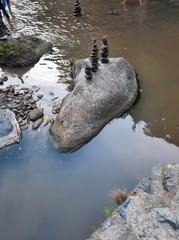Comprehensive Guide to Visiting Alas Kedaton, Denpasar, Indonesia
Date: 16/08/2024
Introduction
Alas Kedaton Temple, also known as Pura Dalem Kahyangan Kedaton, is a historically and culturally significant site situated in the Tabanan Regency of Bali, Indonesia. This temple, enveloped in a sacred monkey forest, is a testament to Bali’s rich heritage and deep-rooted Hindu traditions. Constructed in the 14th century by the revered priest Mpu Kuturan during the reign of King Sri Masula Masuli, Alas Kedaton stands out not just for its unique architectural features but also for its spiritual significance. The temple complex is dedicated to the principal Hindu deities—Shiva, Vishnu, and Brahma—and plays a pivotal role in the religious life of the local Hindu community. Visitors to Alas Kedaton are treated to a blend of historical insights, cultural richness, and natural beauty, making it a must-visit destination for those exploring Bali. The forest surrounding the temple is home to a thriving population of long-tailed macaques and large bats, adding a touch of wilderness to the serene spiritual atmosphere. This guide aims to provide comprehensive information on visiting Alas Kedaton, including its historical background, architectural details, cultural significance, and practical visitor tips to enhance your experience. (baliglory.com, budayabali.com, individualbali.com, baligreentour.com)
Table of Contents
- Introduction
- Historical Background
- Architectural Features
- Cultural and Religious Significance
- Visitor Information
- Interaction with Wildlife
- Preservation and Modern-Day Relevance
- Temple Festivals and Ceremonies
- Nearby Attractions and Travel Tips
- Conclusion
- FAQ
Historical Background
Origins and Construction
Alas Kedaton Temple’s origins trace back to the 14th century, during the reign of King Sri Masula Masuli. According to inscriptions found in Sading Village, Mengwi, Badung Regency, King Sri Masula Masuli began his reign in Saka 1100 (1178 AD) and ruled for 77 years until Saka 1177 (1255 AD) (baliglory.com). The temple was constructed by Mpu Kuturan, a revered Hindu priest who significantly contributed to the spread of Hinduism in Bali and the establishment of customary village rules. Mpu Kuturan is credited with building several important temples in Bali, including Alas Kedaton, one of the six Sad Kahyangan temples dedicated to Shiva and the ancestors (budayabali.com).
Architectural Features
Alas Kedaton Temple stands out with its unique architectural layout. Unlike most Balinese temples where the inner courtyard (Jeroan or Utama Mandala) is higher than the middle courtyard (Jaba or Madya Mandala), Alas Kedaton’s inner courtyard is lower than the middle courtyard. This distinctive feature sets it apart from other temples on the island (baliglory.com). The temple complex is divided into three main courtyards: the outer courtyard (Nista Mandala), the middle courtyard (Madya Mandala), and the inner courtyard (Utama Mandala). The temple is also notable for its four gates, which serve as entrances and exits, distinguishing it from other Balinese temples (individualbali.com).
Cultural and Religious Significance
Alas Kedaton Temple holds deep cultural and religious significance for the Balinese Hindu community. The temple is dedicated to the worship of Shiva, Vishnu, and Brahma, the principal deities in Hinduism. On certain days, such as Kuningan, Galungan, and Tumpek Kandang, Hindus perform prayers and rituals at the temple, making it a vital place of worship (budayabali.com).
The temple is also associated with several legends and myths. One such legend involves King Sri Masula Masuli, who is said to have received a revelation from Shiva instructing him to leave his palace and meditate on Mount Agung. Following the king’s departure, the palace and temple were left to the monkeys and bats, now considered the guardians of Alas Kedaton (budayabali.com).
Visitor Information
Visiting Hours and Tickets
Alas Kedaton Temple is open daily from 8:00 AM to 6:00 PM. The entrance fee is IDR 20,000 for adults and IDR 15,000 for children. It’s recommended to visit early in the morning or late in the afternoon to avoid the midday heat and enjoy a more serene experience.
Travel Tips and Accessibility
Alas Kedaton is easily accessible from various parts of Bali. It is located approximately 25 kilometers from Denpasar and 10 kilometers from Tabanan. Public transportation options are limited, so renting a car or hiring a taxi is advisable. Comfortable walking shoes, sunscreen, and insect repellent are recommended due to the temple’s forested environment.
Interaction with Wildlife
One unique aspect of Alas Kedaton is its harmonious coexistence with wildlife. The forest is home to approximately 2,000 monkeys, primarily long-tailed macaques, who freely roam the temple grounds. These monkeys are considered custodians of the temple and are known for their playful and curious nature. Visitors can interact with the monkeys, feed them, and take photographs, although caution is advised as the monkeys are known to snatch hats and glasses (baligreentour.com). In addition to monkeys, the forest is inhabited by large bats and various other animals, adding to the mystical and serene atmosphere of the temple.
Preservation and Modern-Day Relevance
Despite its historical and cultural importance, Alas Kedaton has faced challenges in recent years. The temple and its surrounding forest experienced a decline in visitor numbers, partly due to a lack of awareness and development in tourist attraction management. The COVID-19 pandemic further exacerbated this decline, reducing daily visitors from 400-800 to just 50-150 (budayabali.com). Efforts are being made to preserve and promote Alas Kedaton as a tourist destination. The temple and forest serve as a training facility for nature conservation, environmental studies, and agro-tourism. Additionally, the local community has established small shops selling handicrafts, food, and beverages to support tourism and provide amenities for visitors (baligreentour.com).
Temple Festivals and Ceremonies
Alas Kedaton Temple hosts a significant temple ceremony every 210 days according to the Balinese Hindu calendar. This ceremony, known as Anggarakasih Medangsia, is performed to request safety and prosperity for the community. The ritual is unique in that it does not involve the use of fire or penjor (decorative bamboo poles) and must be completed before sunset (baligreentour.com). The temple festival is a vibrant event that attracts both locals and tourists, offering a glimpse into the rich cultural traditions of Bali. The ceremony includes various offerings, prayers, and traditional performances, providing an immersive cultural experience for visitors.
Nearby Attractions and Travel Tips
When visiting Alas Kedaton, consider exploring other nearby attractions in Tabanan. The famous Tanah Lot Temple and Jatiluwih Rice Terraces are not far from Alas Kedaton and offer additional cultural and natural experiences. Guided tours are available for a more in-depth understanding of the area’s history and significance.
Conclusion
Alas Kedaton Temple is a remarkable site that embodies the rich cultural heritage and natural beauty of Bali. Its historical significance, unique architectural features, and harmonious coexistence with wildlife make it a must-visit destination for those seeking an authentic Balinese experience. Despite facing challenges in recent years, efforts to preserve and promote the temple continue, ensuring that it remains a cherished part of Bali’s cultural landscape.
FAQ
Q: What are the visiting hours for Alas Kedaton Temple? A: Alas Kedaton Temple is open daily from 8:00 AM to 6:00 PM.
Q: How much is the entrance fee for Alas Kedaton Temple? A: The entrance fee is IDR 20,000 for adults and IDR 15,000 for children.
Q: What is the best way to get to Alas Kedaton Temple? A: Renting a car or hiring a taxi is advisable as public transportation options are limited.
Q: Can visitors interact with the wildlife at Alas Kedaton? A: Yes, visitors can interact with the monkeys and other wildlife, but caution is advised.
Q: Are there any nearby attractions to visit after Alas Kedaton? A: Yes, nearby attractions include Tanah Lot Temple and Jatiluwih Rice Terraces.
Call to Action
Plan your visit to Alas Kedaton Temple to experience its rich history and serene beauty. For more information on Bali’s cultural heritage, download the Audiala mobile app, check out our related posts, and follow us on social media for updates.




